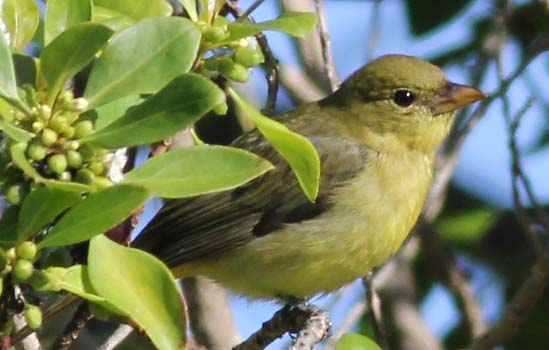'TOP 10' BIRDS AT PT. PINOS |
My
choices for the ten best birds ever seen within or from (sea-watching
counts!) the Pt. Pinos area are set out below. If a photo was taken of
the bird itself, that photograph is used here. If not, I've included a
photo of the location with an inset of a painting of the species that
was there (and, if available, a sketch of the actual bird):
#1 Yellow Rail at Crespi Pond 2-8 Oct 1970
As
I understand the story, a Yellow Rail flushed from the grassy
golf-course edge of the pond, near the 17th tee, and fluttered towards
the Crespi reeds, about in the locality of this photo. It was seen in
flight by Bill Reese on 2 Oct. Rich Stallcup saw it at the same spot on
8 Oct. The small dark rail showed the characteristic white primaries
(as shown in this Doug Pratt painting from the cover of Birding
magazine in June 1981). Details by Reese and Stallcup were accepted by
the CBRC; a report of it again on 1 Nov did not have details and was
not accepted.
A century ago Yellow Rails
wintered in fair numbers in coastal marshes along the California coast,
and there is report of a specimen taken in Nov 1905 on the MTY side of
the Pajaro River. The specimen was presumably lost in the 1906
earthquake and fire in San Francisco. Today, Yellow Rail is an
exceptional rarity to the coast but occurs occasionally in saltwater
marshes. To have had one on this freshwater pond is truly remarkable. |
|
|
#2 LeConte's Sparrow in brush near Crespi Pond 19 Oct 1974
LeConte's
Sparrow is very rare in California, and this was just the second State
record. After a boat trip on 19 Oct 1974, Bob & Carol Yutzy, Greg
Butcher, and Eugene Makishima decided to go check Pt. Pinos. Bob
writes: "We were birding Crespi Pond late in the afternoon and Greg and
I were checking ... at the extreme NE corner of the golf course, while
Eugene and Carol were checking the other side of the cypresses. Greg
and I spotted a skulking sparrow under some low hanging cypress limbs
in the shadows. We called over Carol and Eugene. It was hard to get
field marks on the bird down in the shadows of the cypress trees but we
kept watching and pooling the information on what we were all seeing.
We all knew it was a good one for California ... but Greg said if he
was back East (where he was from) he would ID it as a LeConte's
Sparrow. ... So we called Alan [Baldridge] even though it was getting
late [and he called] Ron Branson to come ... get some pictures . . . We
waited for Ron while watching the bird and though it was fairly late
... he got some photos" [photo © R.L. Branson].
That was a
new story for me, and it clarifies that the sparrow was not at the edge
of Crespi, as I had thought, but was skulking under the cypress row to
the east. Alas, all undergrowth there has since been removed. |
#3 Mottled Petrel seen from Pt. Pinos ('Petrel Pt.') 12 Dec 1984
By
early afternoon on 12 Dec 1984, gale force northwest winds were
pounding the Monterey Peninsula. I decided to try sea-watching from my
car. The winds were so strong at the Point itself that the car was
rocking as I tried to scope out the window. I drove a bit east to a
public pull-out (which I now call "Petrel Pt.") because there is a spot
where one can park and be sheltered from the brunt of NW winds. Lots of
fulmars were passing by, struggling to go west out of the Bay, and
among them, amazingly, was a Mottled Petrel at kelp-line, bounding in
high arcs as a master of the winds, working its way west. I had time to
get multiple views of the ventral & dorsal aspects, and drew a
quick sketch in the car (inset in photo left). Later this compared well
(e.g., to Peter Harrison's art from his 1983 Seabirds book).
The record was CBRC accepted as a first for MTY. It was only the 2d
ever seen from shore in California [the other from Pt. Mugu, Ventura
Co., 30 Dec 1981]. There have been 3 in MTY since 1984; one of them
found injured on-shore in Seaside.
|
|
|
#4 Eastern Yellow Wagtail at 'Crespi Beach' 19 Sep 1982
There
is a small rocky beach just across Ocean View Blvd from Crespi Pond.
Wave-borne kelp washes up here, attracting flies as it decays, and the
flies attract birds. On the Sunday morning of 19 Sep 1982, Jon Dunn was
leading a Wings Tour here and found the imm Yellow Wagtail. Local
birder Ron Branson was simply out birding, and Jon called him over to
see the vagrant with the tour group. It had landed briefly, wagging its
way along the pebbly shore, but did not stay long. Like most such
wagtails in California, it was a brief 'one-day wonder' that was gone
by the time others, alerted by Jon, reached the site. At the time this
was just the 4th record for the State. Ten years later there are 14
records, and all of them within the narrow time window in fall
migration of 27 Aug–21 Sep [drawing of 1st-cycle yellow wagtail by Bill
Zesterstrom in Alström & Mild's (2003) Pipits & Wagtails].
|
#5 Yellow-bellied Flycatcher at 'Crespi cypresses' 21 Sep 2004
On the morning of 21 Sep 2004, as I was completing my loop around Crespi Pond, I found this interesting Empidonax
flycatcher. To me it looked 'tiny,' short-tailed, short-billed, with a
big round eyering, on a bird that was green above and very bright
yellow below. It also had black wings with which the white wingbars and
tertial edgings contrasted strongly. And it gave a call I did not
recognize: a sharp spweek! with a squeaky or sneezy quality
to it, a little like a rubber ducky. So I tried a few digiscope pics as
the bird was cooperative in sitting on the fence surrounding the City's
maintenance yard. There were numerous points that suggested
Yellow-bellied Flycatcher. After posting to the Birdbox, many observers
got to see it and additional photos taken. I got to spent another 1.5
hour with it in the evening, but it only stayed this one day. More
details are at this link. In due
course, it was accepted by CBRC as the first MTY record, and the 12th
for California. This denizen of the northeastern spruce forest is a
very rare bird in California and given the difficulty of separating Empidonax, its documentation here was gratifying for all observers.
|
|
|
#6 Slaty-backed Gull at Pt. Pinos 5 Feb 2007
Right
at the tip of Pt. Pinos is large public pull-out adjacent to a little
sandy beach that separates the pull-out from the rocks at the
northwesternmost reach of the Point. Tourists regularly walk this beach
and, at low tide, use it to clamber up into the Pt. Pinos rocks. But
early in the morning, or in bad weather, gulls use it as a favored
resting spot. Yet, because of the tides and the tourists, they are
rarely there for long. But at 8 a.m. of the morning of 4 Feb 2007,
among 50 or so gulls, Brian Sullivan found MTY's first Slaty-backed
Gull (left © B.L. Sullivan). Note the very pale eye on the
second-cycle large Larus; the pale wing coverts but all black
primaries; and the dark-gray color of the new back and scapular
feathers, along with size, stance, and bill shape. A number of Arctic
migrant gulls were also there that morning, including 11
Glaucous-winged and one Glaucous Gull. California now has records of
~50 Slaty-backed Gulls, but so far only two have been well-documented
here in MTY.
|
#7 Snow Bunting on 'Crespi beach' 23-26 May 2009
One
of the most unexpected birds at Pt. Pinos, considering the date of its
occurrence, was this female Snow Bunting present from 23-26 May (photo
26 May © D. Roberson). Found by visiting birder Daniel Gilman on
the beach across from Crespi Pond, it remained at its favored spot near
tideline for many happy birders until it left on the first clear night
after its discovery. This was the 3rd record for MTY and was the latest
spring record for California. It was hard to imagine this Arctic
breeder so far south and so late in spring. However, a female Snow
Bunting at Ocean Beach, San Diego Co., 30 Apr-7 May had been both
unusually late and exceptionally far south. Peter Pyle & Brian
Sullivan [Western Birds 41: 261-265 + back cover, 2010]
compared close-up photos of the San Diego and Pt. Pinos bird, and
determined they were of the same individual! So this wayward Snow
Bunting was doubly amazing.
|
|
|
#8 one Hawaiian Petrel seen from Pt. Pinos 11 May 2014
and another seen just off the Point from a boat 25 Aug 2014
This collage (left) shows a
Hawaiian Petrel from two perspectives. In the foreground is Peter J.
Dunn's great photo of a Hawaiian Petrel, taken from a whale-watch boat,
with the Pt. Pinos Lighthouse in the background. To date the only
Hawaiian Petrel actually seen from shore was on 11 May 2014 by Blake T.
Matheson, while sea-watching. His field sketch is inset at upper right
in the photo.
Initially Hawaiian Petrel Pterodroma sandwichensis was lumped with Galapagos Petrel P. phaeopygia
as "Dark-rumped Petrel." These were split after a 2002 research paper
found them to be distinct species. Hawaiian Petrel was first recorded
in California waters in May 1992 but since then pelagic surveys more
than 50 miles offshore have proven them to be regular in small numbers
from about April through August. Several have been seen in Monterey
Bay, but these two observations from and just off the Point are the
only ones right near the coast.
|
#9 Cook's Petrel seen from Pt. Pinos 18-19 Jan 2010
This fanciful collage (right) has a painting of Cook's Petrel (from Harrison's Seabirds)
and shows Brian Sullivan looking out to sea, but does not show Brian
looking at a Cook's Petrel. But Brian is responsible for the 3 records
of Cook's Petrel seen from Pt. Pinos. During July-Sep 2009 there were
hundreds, maybe thousands, of Cook's Petrel in waters offshore MT. Some
lingered during this 'El Niño' warm–water year into early winter
as 3 were seen from shore at Pt. Pinos on these two dates in
mid-January. Brian Sullivan had the first at some distance mid-day on
18 Jan. He telephoned me, and I had a Cook’s at 3:45 p.m. that date.
Both were heading west out of the Bay in strong, gusty winds, mostly
from S and SW. Huge breakers were then hitting shore from offshore
storms. Sullivan had another, a bit closer, on 19 Jan 2010. The Cook's
Petrel that became California's first specimen was found in a Santa
Cruz, SCZ, driveway on 17 Nov 1983, but otherwise nearly all birds have
been far offshore. So scoping them from a coast-based observation point
is quite impressive.
|
|
|
#10 Mountain Bluebird on 'John Denver beach' 9-12 Oct 2009
Late
on 9 Oct 2009, visiting birders from the Iowa Ornithological Union (Jim
Bangma et al.) discovered a female-like Mountain Bluebird on a beach
near Pt. Pinos, and it was present again the next morning. This is the
beach the locals call the "John Denver beach," as his plane crashed
just off this beach on 12 Oct 1997. At the time there was a homemade
memorial, including a large driftwood with Denver's name on it. The
bluebird often sat on that driftwood (photo 12 Oct © D. Roberson)
or hovered over the beach. It was still present on the 12th anniversary
of Denver's death, 12 Oct 2009 (at which time the memorial had
flowers). A sentimental spirit might even attribute the lovely bird to
the Rocky Mountain songster. A permanent plaque commemorating Denver is
now embedded in a rock here. These circumstances made this first-cycle
male Mountain Bluebird memorable. There are only two prior records on
the Monterey Peninsula, both at Pt. Pinos: 21-22 Oct 1972 & 14 Oct
1979.
|
|
| |
|
| It is difficult choosing a "top ten best birds" at Pt. Pinos because so many vagrants have occurred. While sea-watching,
birders have seen almost the entire panoply of Pacific seabirds while
standing (or sitting in their cars) onshore. In the photo above —
that's Pt. Pinos in the background — over 60 Sooty Shearwaters (and 1
Western Gull) are in the frame (19 May 2007 © D. Roberson).
Observers on-shore can sometimes see multiple thousands of these
shearwaters passing by over a couple hours. In windy conditions, they
are pushed much closer to shore than in this shot. |
It
is much more difficult to get photos of seabirds flying by the Point ,
given the weather conditions, the speeds at which the birds are flying,
and the fact that most viewing is through birding 'scopes. Still, Brian
Sullivan managed this shot of a rare Horned Puffin
flying past the Point on 7 March 2007 (right © B.L. Sullivan). At
least 2 more were seen flying past the Point that day or the next.
Other impressive seabirds seen from shore at Pt. Pinos include:
- Short-tailed Albatross — at least 3 birds in recent years, plus they were seen regularly from shore here in the 1800s
- Laysan Albatross — about a half-dozen records from shore
- Flesh-footed Shearwater — perhaps a dozen seeb from the Point
- Manx Shearwater — multiple observations from shore in the last 25 years
- Fork-tailed Storm-Petrel — in extraordinary times, dozens present (Sep-Nov 1958, Aug-Sep 1983), but usually rare
- Leach's Storm-Petrel — several times during very strong winds
- Least Storm-Petrel — at least twice during El Niño conditions
- Boobies: multiple records of Brown and Blue-footed, one of Red-footed — and a record of Nazca Booby is currenlty pending with CBRC
- all the jaegers (but Long-tailed by far the rarest from shore) plus a couple South Polar Skua
- a fly-by Thick-billed Murre accepted by CBRC
- multiple Ancient, Marbled, and Scripps' Murrelets, and at least two Guadalupe Murrelets
- more than a dozen shore-based records of Tufted Puffin flying by
|
|
|
|
| Meanwhile, a surprising selection of waterbirds have appeared on Crespi Pond.
One of my favorite photos is this remarkable shot by John Sorenson
(above; 21 Jan 1995 © J. Sorensen) that shows a female Common Merganser (left) side-by-side with a female-plumaged Red-breasted Merganser (right).
Common Merganser is a major rarity here; Red-breasted Merganser is
regular along the coast in fall and winter. However, to have them
side-by-side to compare things like the shape of the bill, their
posture, structure and color of the crest, and the presence or absence
of white throat patch is amazing. |
A spectacularly unseasonable waterbird at Crespi was this "Blue Goose"
morph of Snow Goose — actually the first record of this morph in the
county — that summered with a pair of Canada Goose and their two young
from early June 2012 onwards (right, photo 4 June 2012 © Bill
Hill).
Surely the rarest waterfowl ever present was a Fulvous Whistling-Duck
20 Oct-30 Nov 1974 (Art Edwards, Rich Stallcup et al.), back in the
days when that species was much more regular in California as a whole.
It is surely in the running for the "top ten" list.
Species that are more regular in MTY, but are still unusual and especially so on Crespi Pond, include Solitary Sandpiper (juv below 20 Sep 2004 © D. Roberson; this was when Crespi was low enough to have a tiny bit of mudflat) and Long-tailed Duck (28 Mar-10 Apr 1994, photo Apr 94 © John Sorensen).
|
|
|
|
|
|
| As to vagrant landbirds,
almost all of our semi-regular eastern vagrants have appeared either at
the cypresses around Crespi Pond, or in the neighborhoods that stretch
east to Esplanade Park. September-October are the prime months, and
most vagrants found are HY [=hatch-year] individuals, such as this imm Chestnut-sided Warbler
(above 5 Oct 2008 © D. Roberson). The most common of 'eastern'
vagrants around Crespi are birds like Blackpoll & Palm Warblers;
Clay-colored, Swamp, and White-throated Sparrows; and Bobolink. |
 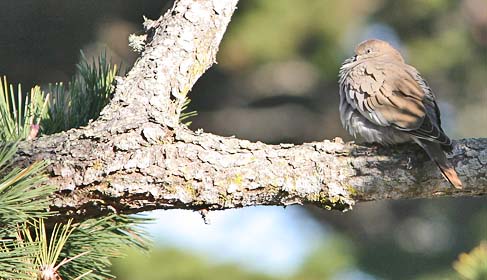 Much rarer are southeastern vagrants like Hooded Warbler; skulkers like Mourning Warbler; or vagrant flycatchers, such as Scissor-tailed Flycatcher (far right 8 May 1990 © D. Roberson; the only record for the Point). Much rarer are southeastern vagrants like Hooded Warbler; skulkers like Mourning Warbler; or vagrant flycatchers, such as Scissor-tailed Flycatcher (far right 8 May 1990 © D. Roberson; the only record for the Point).
The Esplanade Park neighborhoods have had such impressive birds as White-winged Dove
(near right 26 Nov 2005 © D. Roberson), Phainopepla, Gray Catbird,
and Prothonotary and Cape May Warblers. Two of the best, though, are
this female Scarlet Tanager (below left 25-26 Oct 2001 © Sarah Lane), found by Blake Matheson in the cemetery, and this Yellow-green Vireo (below right 9-12 Oct 1988, photo 9 Oct © Bob Tintle), in a yard just two houses east of Esplanade Park.
|
|
|
|
| |
A BRIEF HISTORY OF BIRDING AT PT. PINOS
by Don Roberson |
Pt.
Pinos and environs have been known as a bird-attracting area since the
first ornithological surveys here. The point is named for the many
native Monterey Pines that grow to the shoreline edge among the old
sand dunes at the point. The unique freshwater vernal pool is named for
friar Juan Crespí who accompanied father Junípero Serra
to found a mission on Monterey Bay in 1770. Of course, these environs
are now much changed. The old sand dunes at the point are now a public
golf course. Crespi Pond is now maintained year-round as a golf course
pond by the City of Pacific Grove. Private homes (all now quite
expensive) make up neighborhoods with ornamental plantings, and the
pine forest is much reduced (although good numbers of pines still
exist). Fortunately, long ago the City of Pacific Grove obtained the
shoreline as public land, so there are wonderful views of the ocean.
South of Pt. Pinos the views are west into the Pacific Ocean and the
numerous pull-outs attract visitors each clear evening to watch the
sunset. East of Pt. Pinos the views are into Monterey Bay, and this
shoreline park is alive in color each spring with P.G.'s "purple
carpet" of ornamentals.
Frank Chapman tells about camping in Pacific Grove and birding at the Point in late May 1903 with Louis Fuertes (Camps & Cruises of an Ornithologist,
1908). He says that Monterey was already "famous among students of
Pacific Coast bird-life." Of the 40 species seen, one was a vagrant
Clark's Nutcracker! From the late 1930s, the Pt. Pinos area was birded
by Laidlaw Williams and local Monterey Peninsula Audubon Society
members. Roger Tory Peterson & James Fisher, in their famed book Wild America (1955), talk about birding along the shoreline here, with Laidlaw Williams, in June 1953.
Pt.
Pinos's potential as a vagrant trap appears to have been first tapped
in the fall of 1965 when Ron Branson found Palm and Blackpoll Warblers
here, and then it really took off in fall 1966 with discoveries of many
first county records here by Branson, Bill Reese, and Vern Yadon,
abetted by visitors like Dave DeSante. By fall 1969 the Point was
regularly attracting birders from the San Francisco Bay Area, such as
Laurence C. Binford and the Greenberg family. Rich Stallcup's presence
here was felt most strongly from 1969-1972, and he lived in the
vicinity during the autumns of 1971 & 1972. A substantial portion
of today's data base of bird records comes from these pioneers. I moved
here in 1979 and chose an apartment as close to Pt. Pinos as I could
get (3 blocks away); I birded the Point and vicinity heavily in the
early 1980s.
By the mid-1980s changes were
apparent. Golf course usage became much heavier, and, although other
Audubon members & I testified against it, a driving range was
installed and then expanded. This driving range, adjacent to a row of
Monterey Cypresses which had hosted an incredible number of rarities,
essentially cut-off public access to this prime locale. The driving
range also wiped out a naturally grassy field that had once attracted
migrant sparrows. Crespi Pond itself was continually modified, dredged,
and the subject of local committee reviews (on which I have served from
time to time, as have other local birders like Rita Carratello, Steve
Bailey, and Brian Weed). Efforts to manage the Pond primarily as bird
habitat have taken second place to the income-producing golf course. By
the 1990s, the City's maintenance yard, which had always been open to
birders among those cypresses, was fenced and locked, providing only
occasional access to locals with permission. For all these reasons, I
have tended to bird elsewhere more often (e.g., Carmel R. mouth, Big
Sur R. mouth, or the Moss Landing area) and de-emphasize the Point. The
"Esplanade" (a public park) and its vicinity received good coverage in
1996 when Steve Rovell rented a home there for a time, and Jim Booker
and he regularly searched the flowering bottlebrush. And, of course,
the area is still prized for the chance of rarities during the annual
Christmas Bird Count.
Things perked up when
Brian L. Sullivan, an eBird project leader, moved to Pacific Grove and
took up serious sea-watching at the Point. He added many impressive
sea-birds during his local residence nearby from 2006-2010. A number of
local birders (including Brian, who now lives farther away, and I)
still visit regularly to sea-watch, especially in high winds when
seabirds can be pushed inside the kelp line as they struggle out from
Monterey Bay. Sea-watching at Pt. Pinos got a huge boost in late 2015
when Monterey Audubon sponsored a formal, protocol-based dawn-to-dusk
seawatch from 1 Nov to 15 Dec. Noted hawk-and-sea-watcher Tony
Leukering was hired to undertake this monumental effort, often aided as
time permitted by local volunteers. Many more details and photos are in
the seasonal highlights for late 2015.
The
various public pull-outs to view Monterey Bay between Crespi Pond and
Otter Pt. now have names adopted by local birders. The little pebble
beach just across from Crespi Pond is called "Crespi beach." The next
one available to the east has a larger sandy beach, a large rocky islet
just offshore, and is often a busy gull roost. It was just off this
beach that songwriter/singer John Denver crashed in an experimental
single-person airplane on 12 Oct 1997. Today a permanent commenorative
plaque is embedded there. The next pull-out available to the east,
before one reaches Esplanade, is known as "Petrel Pt." for the Mottled
Petrel seen from there in a gale on 12 Dec 1984.
|
|
|
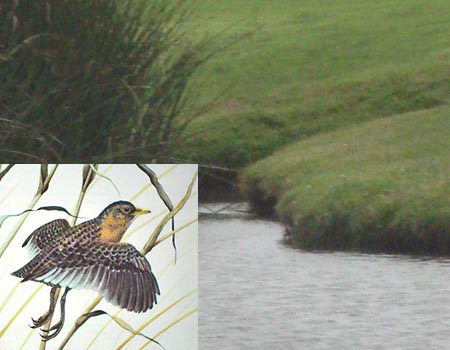

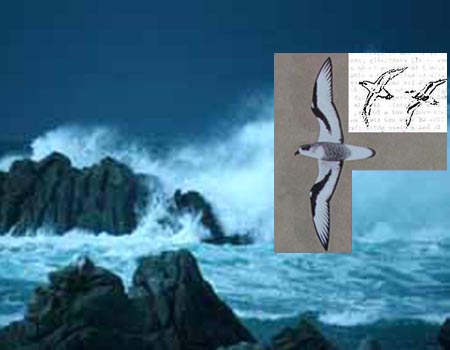
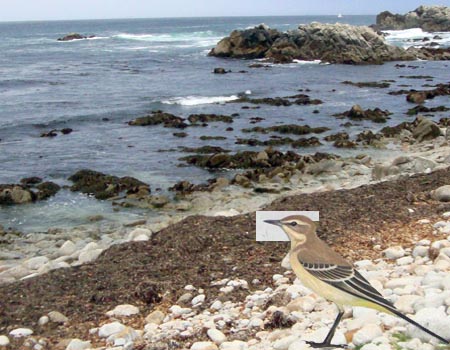


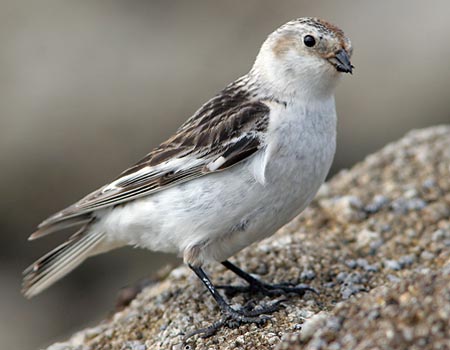






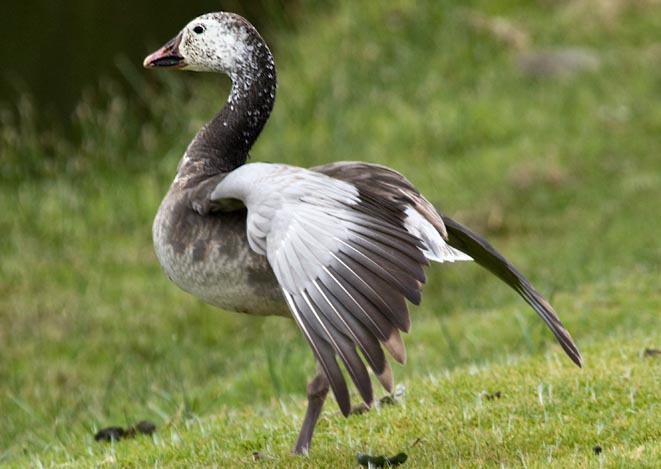
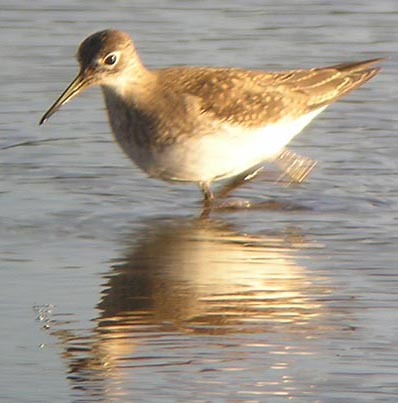
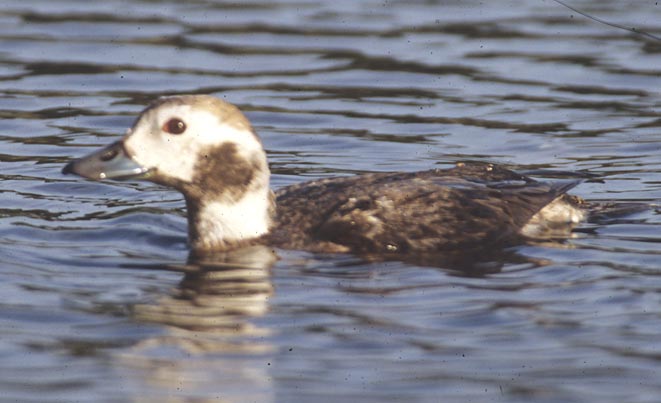


 Much rarer are southeastern vagrants like Hooded Warbler; skulkers like Mourning Warbler; or vagrant flycatchers, such as Scissor-tailed Flycatcher (far right 8 May 1990 © D. Roberson; the only record for the Point).
Much rarer are southeastern vagrants like Hooded Warbler; skulkers like Mourning Warbler; or vagrant flycatchers, such as Scissor-tailed Flycatcher (far right 8 May 1990 © D. Roberson; the only record for the Point). 